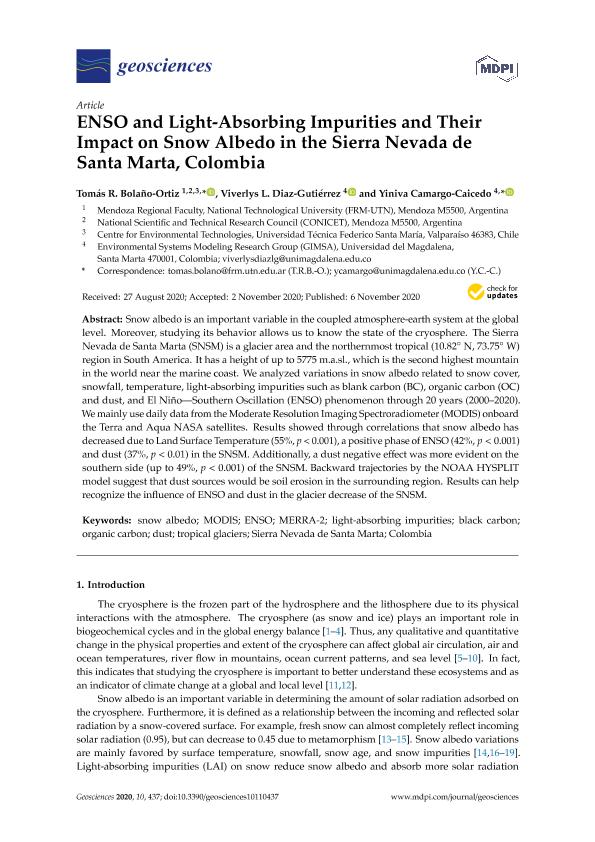Artículo
ENSO and light-absorbing impurities and their impact on snow albedo in the Sierra Nevada de Santa Marta, Colombia
Fecha de publicación:
11/2020
Editorial:
Molecular Diversity Preservation International
Revista:
Geosciences (Switzerland)
ISSN:
2076-3263
Idioma:
Inglés
Tipo de recurso:
Artículo publicado
Clasificación temática:
Resumen
Snow albedo is an important variable in the coupled atmosphere-earth system at the global level. Moreover, studying its behavior allows us to know the state of the cryosphere. The Sierra Nevada de Santa Marta (SNSM) is a glacier area and the northernmost tropical (10.82◦ N, 73.75◦ W) region in South America. It has a height of up to 5775 m.a.sl., which is the second highest mountain in the world near the marine coast. We analyzed variations in snow albedo related to snow cover, snowfall, temperature, light-absorbing impurities such as blank carbon (BC), organic carbon (OC) and dust, and El Niño—Southern Oscillation (ENSO) phenomenon through 20 years (2000–2020). We mainly use daily data from the Moderate Resolution Imaging Spectroradiometer (MODIS) onboard the Terra and Aqua NASA satellites. Results showed through correlations that snow albedo has decreased due to Land Surface Temperature (55%, p < 0.001), a positive phase of ENSO (42%, p < 0.001) and dust (37%, p < 0.01) in the SNSM. Additionally, a dust negative effect was more evident on the southern side (up to 49%, p < 0.001) of the SNSM. Backward trajectories by the NOAA HYSPLIT model suggest that dust sources would be soil erosion in the surrounding region. Results can help recognize the influence of ENSO and dust in the glacier decrease of the SNSM.
Archivos asociados
Licencia
Identificadores
Colecciones
Articulos(CCT - MENDOZA)
Articulos de CTRO.CIENTIFICO TECNOL.CONICET - MENDOZA
Articulos de CTRO.CIENTIFICO TECNOL.CONICET - MENDOZA
Citación
Bolaño Ortiz, Tomas Rafael; Diaz Gutiérrez, Viverlys L.; Camargo Caicedo, Yiniva; ENSO and light-absorbing impurities and their impact on snow albedo in the Sierra Nevada de Santa Marta, Colombia; Molecular Diversity Preservation International; Geosciences (Switzerland); 10; 11; 11-2020; 1-21
Compartir
Altmétricas




